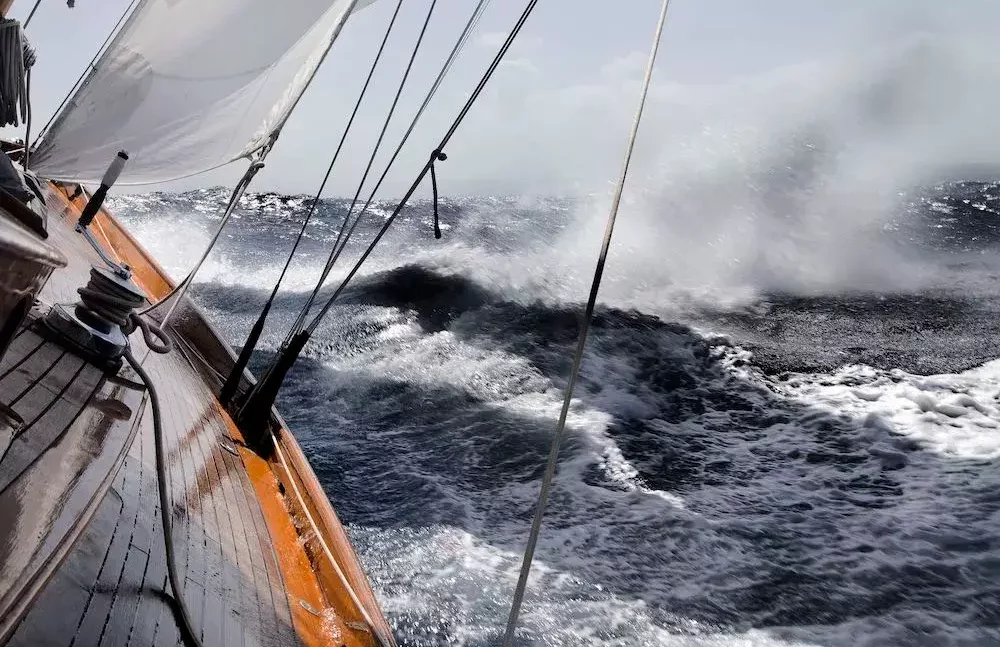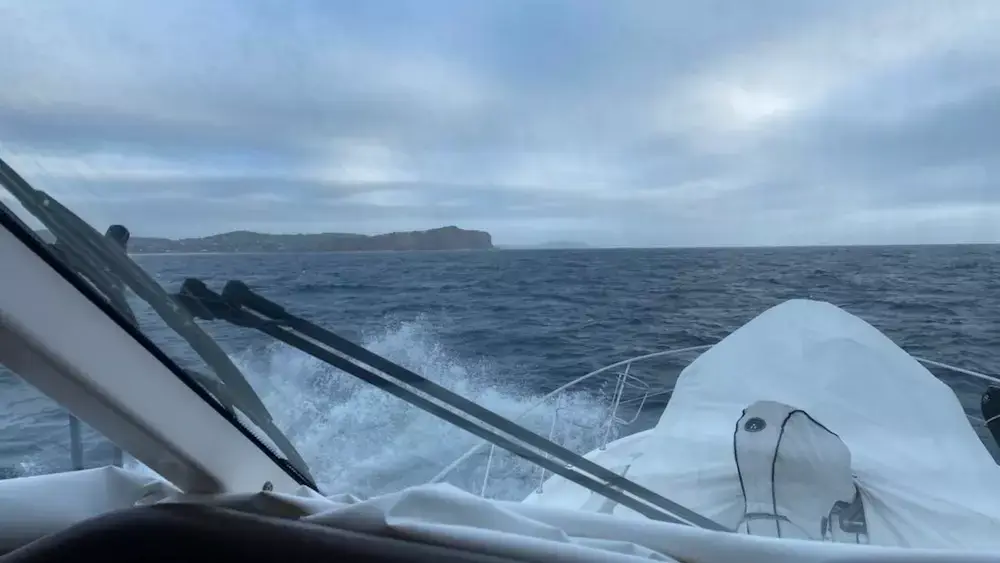It’s no secret that wind can make boating difficult. Too much wind can be downright dangerous. If you’re not prepared for how wind can affect your boat, you could find yourself in trouble on the water.
In this blog post, we’ll talk about how to stay safe when boating in high winds.
We’ll cover topics such as reading the weather forecast, what to do if you encounter high winds while boating, and how to prepare your boat for adverse conditions. Stay safe out there.
When boating, it’s important to be aware of the forecasted weather conditions. For example, if there is a chance of high winds, it’s best to avoid going out on the water.
Even if the wind isn’t blowing very hard, it can still make boating difficult and dangerous.
How to Utilize Wind Forecasts

When you’re out on the water, the wind is one of the biggest dangers you face. Too much wind can cause your boat to capsize or even flip over. So how do you know when the winds are too strong for boating?
One way to check is to consult a wind forecast. Wind forecasts give you an idea of how strong the winds will be in a certain area at a certain time.
You can find wind forecasts online, or you can consult your local weather station.
You can also listen to wind forecasts on the radio, how many people check their weather. These forecasts will give you an idea of how strong the winds will be at different times during a certain day or night.
The stronger the winds are, then it’s not safe for you to go out boating because there’s a risk of your boat capsizing.
Some wind forecasts also include how strong the waves will be in different areas at different times.
That way, you can check how strong the winds are and how large the waves are expected to be so that you know whether or not it’s safe for you to go out on the water.
You should also check how strong the winds are in different areas of your boat.
For example, if you have a sailboat or a kiteboarder, make sure that it’s not too windy around those parts because they can be dangerous if there’s too much wind there.
Another way to check how strong the winds are is to look at how the trees move.
If the trees are swaying a lot, that means there’s a lot of wind, and it might not be safe for you to go out on the water.
How Much Wind Is Too Much for Boating?
The size of your boat and the severity of the waves will determine how windy it is, but in general, winds speeds over 20 knots (23 mph) are too violent for boating.
This wind strength would severely affect almost all-size boats, and smaller boats may even capsize.
Suppose you’re out on the water and notice the wind picking up. Even if you’re not hitting 20 knots yet, it’s important to know how the winds can change quickly – especially in open waters.
Follow these tips to stay safe while boating in high winds:
- Keep a close eye on the weather forecast and be aware of wind speeds
- Stay in familiar, well-marked waters
- Know your boat’s limitations – how it handles high winds, how much weight it can safely carry, etc.
- If possible, have a second person aboard to help with steering and handling lines
- Keep all boating gear secured
- Slow your speed so you can more easily maneuver the boat and have time to react if necessary
How Does Wind Affect Wave Height?
Waves are generated by wind, and how much of a wave depends on the strength of the wind. An easy way to calculate how big your waves might get is via this formula:
Wave height = 0.000001 x (wind velocity)² / depth³ x fetch length (Source: Nautical Knowledge.)
The problem with this equation is that it relies on how much the wind has been blowing for how long, which can be hard to predict.
Wind velocity refers to how fast the wind is moving in knots. Fetch length refers to how far across the water the wind has blown uninterruptedly.
For example, a square body of water (i.e., a lake) is referred to as having one fetch length; the distance across that body of water would be how long the wind has blown.
The depth refers to how deep the water you’re boating in is at its deepest point (the “fetch length” depends on how shallow it gets).
The above formula works best in open water instead of how waves form around land or other obstacles.
A good rule of thumb is that the longer the fetch length, the larger and more powerful your waves will become.
How Does Wind Affect Boating?

Wind can have several different effects on how your boat performs when you’re out on the water.
First, it can affect how far you see: how much visibility of other boats and objects.
The stronger the wind, the further you’ll be able to see because your eyes won’t have to contend with as many obstructing waves in front of them.
This means that boating when it’s windy is generally safer, as you’ll be able to see other boats and obstacles sooner.
Wind can also affect how quickly your boat moves through the water (the “speed” of the boat).
The faster the wind, the more power it has to push against your sails or hull and move you forward. This is why boats tend to move faster when it’s windy – the wind gives them more power.
However, this increased speed can also make your boat harder to control. The stronger the wind, the more difficult it will be for you to keep your boat on course and avoid obstacles. This is especially true if you’re not used to sailing in high winds.
Wind can also create large waves, as mentioned earlier. The more powerful the wind, the higher and more dangerous these waves will be.
Large waves can cause your boat to tip over or swamp it, leading to serious injury or even death.
When Does Wind Become a Genuine Hazard for Boaters?
The wind is a major factor in how comfortable you are on your boat. It can make sailing or motor boating more difficult, and it can also lead to dangerous situations if the wind is too strong. But how do you know when that happens?
The National Weather Service has a wind advisory system to let boaters know when the wind is becoming too strong.
Advisories are issued for sustained winds of 20-34 mph and 34-47 mph gusts. When these conditions are reached, it is important to take caution while boating.
If you’re already on the water when an advisory is issued, it’s important to find a safe harbor to seek shelter.
Those in smaller boats should head straight for the shore, while larger vessels should head into calmer waters as soon as possible.
If you’re still planning your boating trip and see that there will be wind advisories in effect during your planned trip, it is best to cancel or delay your trip.
However, winds stronger than advisory levels are possible and could cause even more dangerous boaters.
If you encounter these conditions while on the water, you should take immediate action and find a safe harbor immediately.
What Is the Most Suitable Boat for Sailing in Strong Winds?
The type of boat you choose will be a big factor in how well it handles windy conditions.
For example, fishing boats are usually more stable than pontoon boats or ski boats because they have lower centers of gravity and deeper V-shaped hulls.
If you’re looking to buy a boat specifically for windy conditions, there are a few things you should keep in mind.
First, make sure the boat has a heavy-duty windshield and sturdy cleats that can handle strong winds.
Also, look for boats with large cockpits and high gunwales – this will help keep you and your passengers safe and dry in rough seas.
If you already own a boat, there are a few things you can do to make it more wind-resistant.
First, try adding extra ballast to the boat by filling empty water containers or sacks with sand or rocks.
You can also install a windscreen or deflector on your boat to help keep the wind off of passengers and crew members.
Finally, make sure that you keep any equipment or supplies stowed away when not in use, so they don’t get blown overboard by a sudden gust of wind.
How to Drive a Boat in Windy Conditions
Boating in windy conditions can be a lot of fun, but it’s important to know how to do it safely. Here are some tips to help you stay safe on the water:
- Make sure your boat is properly weighted for the wind conditions. A boat that is too light will be blown around by the wind, while a boat that is too heavy will be difficult to control.
- Make sure your passengers are wearing life jackets. A sudden gust of wind can easily knock someone overboard.
- Stay away from other boats and obstacles. A strong gust of wind can cause you to lose control of your boat and run into things.
- Keep a safe distance from shore. If you get into trouble, it will be harder to get back to shore in windy conditions.
- Use common sense. If the conditions are too dangerous, stay off the water. It’s not worth risking your safety for a little bit of fun.
Wind can add an extra level of excitement to your boating experience, but it can also be dangerous. Ensure you know how to handle windy conditions before heading out on the water.
How to Prepare Your Boat for Adverse Conditions?

When wind speeds reach 20 knots or more, take the following precautions:
- Remove all loose items from your boat and dock. This includes seat cushions, coolers, and anything else that could become a projectile in high winds.
- Check that all mooring lines are secure and tight. If you have an anchor, ensure it’s tied to the boat. If you have a deck anchor, retrieve it and secure it with a proper line or chain.
- Check your dock lines for wear and tear. Replace if necessary to prevent breakage in high winds. This is also a good time to ensure that any fenders between the boat and dock are in good condition and properly inflated.
- If you have a canvas top or bimini, make sure it’s fastened securely to the boat.
- Ensure that all hatches and windows are closed and secured.
- If your boat has an outboard motor, remove the spark plugs and store them in a safe place.
- If your boat has a gas tank, turn off the fuel supply and disconnect the line.
- Ensure that you have a Personal Flotation Device (PFD) for each person on board, as well as a sound signaling device.
These precautions will help to keep you safe while boating in high winds. However, it’s important to note that you should never head out on the water in adverse conditions.
If a storm is predicted and you are already out on your boat, remove yourself from the open water as soon as possible and seek shelter at a nearby marina.
Maintenance Tips
One of the best ways to boat in a wind condition is by doing some preventive maintenance. Here are a few tips to keep your boat in good condition:
- Clean the boat and remove any debris that may have been collected on it during the season.
- Inspect all mooring lines, dock lines, and anchors for wear and tear. Replace if necessary.
- Check the canvas top and ensure it’s in good condition. Repair or replace if necessary.
- Make sure that all hatches are closed and sealed, especially before you head out on the water.
- Inflate all fenders between the boat and dock.
- Ensure that you have a full tank of gas before heading out on your boat.
These preventive measures will help keep your boating in good condition and help to ensure a safe outing on the water.
Conclusion
So how much wind is too much for boating? Unfortunately, there’s no definitive answer, as the amount of wind that is too much will vary depending on the boat, its size and weight, and the water conditions.
However, by following these tips, you can help to stay safe while out on the water, even in high winds.

